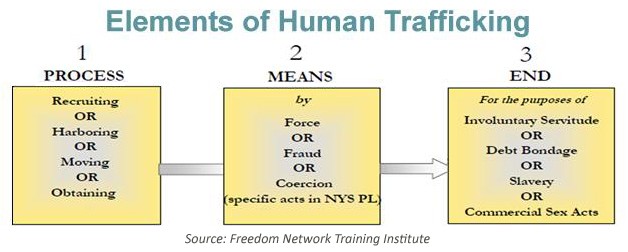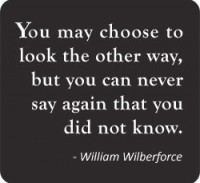By Lima James,
Coordinator of Education & Training
Human trafficking is a form of modern-day slavery and a crime against humanity. This often hidden crime was estimated to be the world’s second largest criminal industry in 2014, second only to the drug trade. It is the fastest growing criminal enterprise worldwide, generating an estimated $150 billion in profits annually (International Labour Organization).
So, what is human trafficking?
The image below shows the elements of human trafficking:

Many individuals in the U.S. believe that human trafficking is something that happens only in other countries like India, China, or Thailand. However, it is important to understand that human trafficking occurs in all countries including the U.S. Polaris, a national leading non-profit organization in the global fight against modern slavery, states that trafficking exists and has been reported in all 50 states—in cities, suburbs, and rural towns.
Anyone—no matter their age, nationality, race, religion, socio-economic status, educational-level, sexuality, or gender—can be a victim of labor or sexual exploitation. They can be foreign born U.S. citizens, immigrants, undocumented individuals, or U.S. born citizens. Although anyone is at risk and children are most vulnerable, those at higher risk of being trafficked are:
- Refugees, immigrants, and non-English-speaking persons
- Runaway and homeless
- Individuals who have been victims of abuse and neglect
- Individuals who have been victims of substance abuse
- Those within the foster care system or juvenile justice system
- LGBTQ individuals
The overwhelming majority of those trafficked are women (80%) and children (50%) (United Nations Office on Drugs & Crime). And, it is estimated that each year as many as 300,000 minors are at risk of being trafficked nationwide. The average entry age is 12-14 years old for girls and 11-13 years old for boys (Department of Justice & National Center for Missing and Exploited Children). Often times, victims are recruited at a very young age and are only rescued as adults.
LifeWay Network has been confronting human trafficking since 2007 by offering education to the general public to raise awareness; and by providing safe housing, since 2009, for women who have been trafficked.
Join us in the anti-trafficking movement by taking small steps such as:
- Browsing LifeWay Network’s website and resources:
- Reading an article or book on human trafficking
- Watching a documentary on human trafficking on YouTube
- Contacting LifeWay Network’s Education & Training Coordinator, Lima James, for resources
- Speaking to your friends and family about what you have learned
**Please note that statistics provided in this article are estimated numbers from the cited agencies. Obtaining concrete statistics on human trafficking activity is extremely difficult and accurate information is often unavailable.**

